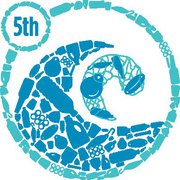
 I spend the last week in Hawaii attending the 5th International Marine Debris Conference. This conference brought together almost 300 scientific experts, activists, educators, policy makers, and artists from all over the world to share and learn from each other. It provided a location and situation for everyone to sit down, make partnerships and begin to make solid plans/commitments for the future with regards to marine debris. I was given the fantastic opportunity to discuss our findings as part of the OceanGybe Expedition and provide a different viewpoint on marine debris.
I spend the last week in Hawaii attending the 5th International Marine Debris Conference. This conference brought together almost 300 scientific experts, activists, educators, policy makers, and artists from all over the world to share and learn from each other. It provided a location and situation for everyone to sit down, make partnerships and begin to make solid plans/commitments for the future with regards to marine debris. I was given the fantastic opportunity to discuss our findings as part of the OceanGybe Expedition and provide a different viewpoint on marine debris.
At first glance, I thought an entire week conference for just the issue of marine debris might be overkill and there would not be enough material to fill the hours. Wow, was I ever wrong. The entire week there were four sessions of speakers running concurrently and people were rushing from meeting room to meeting room trying to catch all the different parties present.
My major goal was to sit down, learn from the many experts, and come back more educated in the facts, figures, obstacles, technical issues and success stories of the marine pollution issue. It was incredible reassuring to see so many groups working on this issue and trying to come up with solutions. However, it also became extremely apparent that despite the efforts of so many good people, it is a difficult issue to study for many many reasons.
There were groups working on monitoring ocean pollution from aircraft and even trying to do it space, groups modeling the movement of pseudo particles in all the world’s oceans , groups looking at heavy metal adsorption by plastics, groups tracking chemicals with marine debris as the trace, groups create huge art installations from beach flip-flops (http://marinedebrisart.blogspot.com/ and http://gallery.me.com/naturefinder#100034) , groups using cameras to try and quantify oceanic plastics (, groups creating curriculum for school teachers (Vancouver Aquarium, Kakua Hawaii Foundation), groups working on policy and creating bans on plastics, groups trying to stop plastic bans (Plastics industry), groups trying to raise money to trawl the ocean’s gyres free of plastics using a series of fishing boats and motherships, and everything in between.
Charles Moore of the Algulita Foundation gave us a review of 10 trips to and from the North Pacific Gyre while The SEA Expedition showed that the North Atlantic Gyre is as polluted as the North Pacific Gyre after there 20 years of monitoring it. In the world of beach clean-ups, I had no idea there were so many groups working diligently to clean their beaches and coastline. Ocean Conservancy’s “International Coastal Clean-Up” program and The Surfrider Foundations clean-up programs are incredible… From small groups of 10 or 20 working on the southern Great Lakes to the 300 000 people mobilized to clean beaches in India! New Zealand, South Africa, the USA and everywhere in between has groups organizing beach clean-ups. Take a look at this link… for the place closest to you.
It was also extremely encouraging to note that OceanGybe does play a very relevant role in the world of plastic in our oceans. Scientists are very good at science but can give some of the most boring presentations on earth; Activists are great at creating change but not at science; Teachers can get the word out but need help with the facts. This is where OceanGybe is able to help out. We have been lucky enough to travel all over the world and look at plastics on beaches; we have seen it first hand and are not just reading it in a journal; we are able to use the platform of sailing, surfing and adventure to engage with students in ways teachers are unable; we can understand what scientists are finding and put their findings in real terms; we can help bring awareness to this issue.
Despite all the differing approaches and global nature of the conference, everyone stood on the same side of the line when it came to REDUCE, REUSE, RECYCLE. The best thing was can do to stop this problem getting worse, and help save our oceans is to REDUCE our usage and dependence on single-use disposable plastics. Yet, if we have to use something, REUSE it, REUSE it, REUSE it as many times you can think of. Then finally, after you can reuse it no longer, make sure you RECYCLE it. Plastic is an incredible material and we need to stop thinking of it as a disposable waste stream but rather an valuable raw resource to put back into the “industrial complex”.
I definitely learnt a huge amount during the conference and we will be working to put more and more of the information onto the website and into our school presentations in the coming months. The review article from the entire conference is being drafted right now and we will post it once it is released.
